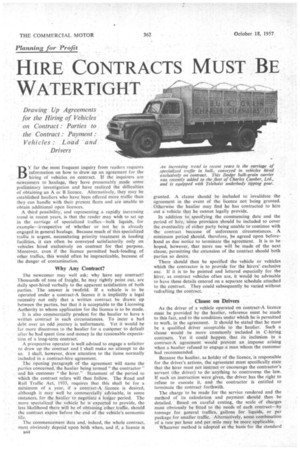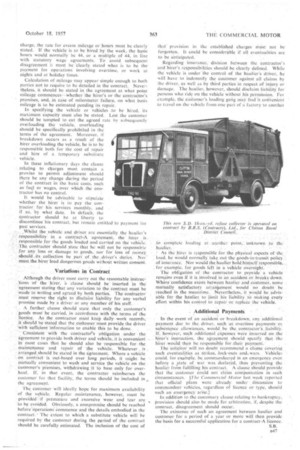HIRE CONTRACTS MUST BE WATERTIGHT
Page 78

Page 81

If you've noticed an error in this article please click here to report it so we can fix it.
BY far the most frequent inquiry from readers requests information on how to draw up an agreement for the hiring of vehicles on contract. If the inquirers are newcomers to haulage, they have presumably made some preliminary investigation and have realized the difficulties of obtaining an A Or B licence. Alternatively, they may be established hauliers who have been offered more traffic than they can handle with their present fleets and are unable to obtain additional open licences.
A third possibility, and representing a rapidly increasing trend in recent years, is that the reader may wish to set up in the carriage of specialized traffics—bulk liquids, for example—irrespective of whether or not he is already engaged in general haulage. Because much of this specialized traffic is urgent, necessitating priority treatment in loading facilities, it can often. be conveyed satisfactorily only on vehicles hired exclusively on contract for that purpose. Moreover, even if the licence permitted back-loading, of other traffics, this would often be impracticable, because of the danger of contamination.
Why Any Contract?
The newcomer may well ask; why have any contract? Thousands of tons of freight, he may rightly point out, are daily spot-hired verbally to the apparent satisfaction of both parties. The answer is twofold. If a vehicle is to be operated under a contract-A licence it is implicitly a legal necessity not only that a written contract be drawn up between the parties, but that it is acceptable to the Licensing Authority to whom application for the licence is to be made.
It is also commercially prudent for the haulier to have a written contract in such circumstances. To incur a bad debt over an odd journey is unfortunate. Yet it would be far more disastrous to the haulier for a customer to default after he had spent time and money in the reasonable expectation of a long-term contract.
A prospective operator is well advised to engage a solicitor to draw up the contract and I shall make no attempt to do so. I shall, however, draw attention to the items normally included in a contract-hire agreement.
The opening paragraph of the agreement will name the parties concerned, the haulier being termed "the contractor" and his customer "the hirer." Statement of the period to which the contract refers will then follow. The Road and Rail Traffic Act, 1933, requires that this shall be for a minimum of a year, if a contract-A licence is desired, although it may well be commercially advisable, in some instances, for the haulier to negotiate a longer period. The more specialized the vehicle he is expected to provide, the less likelihood there will be of obtaining other traffic, should the contract expire before the end of the vehicle's economic 1 ife. . .
The commencement date and, • indeed, the whole contract, must obviously depend upon both when, and if, a licence is a44 granted. A clause should he included to invalidate the agreement in the event of the licence not being granted. Otherwise the haulier may find he has contracted to hire out a vehicle that he cannot legally provide.
In addition to specifying the commencing date and the period of hire, some provision should be included to cover the eventuality of either party being unable to continue with the contract because of unforeseen circumstances. A minimum period should, therefore, be agreed upon beforehand as due notice to terminate the agreement. It is to be hoped, however, that more use will be made of the next clause, permitting the extension of the contract should both parties so desire.
There should. then he specified the vehicle or vehicles which the contractor is to provide for the hirers' exclusive use. If it is to be painted and lettered especially for the hirer, as contract vehicles often are, it would be advisable to have these details entered on a separate schedule attached to the contract.. They could subsequently be varied without redrafting the contract.
As the driver of a vehicle operated on contract-A licence must be provided by the haulier, reference must be made to this fact, and to the conditions under which he is permitted to wofk, in the agreement. It should be stated that he must be a qualified driver acceptable to the haulier. Such a clause would be more commonly included in C-hiring contracts. Yet it could happen that its inclusion in a contract-A agreement would prevent an impasse arising when a haulier refused to engage a man whom the customer had recommended.
Because the haulier, as holder of the licence, is responsible for the driver's actions, the agreenient must specifically state that the hirer must not instruct or encourage the contractor's servant (the driver) to do anything to contravene the law. If such an instruction were given, the driver has the right to refuse to execute it, and the contractor is entitled to terminate the contract forthwith.
The charge to be made for the service rendered and the method of its calculation and payment should then be detailed. Based on careful costing, the scale of charges must obviously be fitted to the needs of each contract—by tonnage for general traffics, gallons for liquids, or per package for smaller traffic. Alternatively, some combination of a rate per hour and per mile may be more applicable.
Whatever method is adopted as the basis for the standard charge, the rate for excess mileage or harks must be clearly stated. If the vehicle is to he hired by the week, the basic hours would normally be 44, or a multiple of 44. in line with statutory wage agreements. To avoid subsequent disagreement it must be 'clearly stated what is to be the payment for operations involving overtime, or work at nights and at holiday times.
Calculation of mileage may appear simple enough to both parties not to require to be detailed in the contract. Nevertheless, it should be stated in the agreement at what point mileage commences— whether the hirer's or the contractors premises, and, in case of mileometer failure, on what basis mileage is to be estimated pending its repair.
In specifying the vehicle or vehicles to he hired, its maximum capacity must also be stated. Lest the customer should be tempted to cut the agreed rate by subsequently overloading the vehicle, overloading should be specifically prohibited in the terms of the agreement. Moreover. if breakdown occurs as a result of the hirer overloading the vehicle, he is to be responsible both for the cost of repair and hire of a temporary substitute vehicle.
In these inflationary days the clause relating to charges must contain a proviso to permit adjustment should there be any change during the period of the contract in the basic costs, such as fuel or wages, over which the contractor has no control.
It would be advisable to stipulate whether the hirer is to pay the contractor. for his services monthly, and if .so, by what date. In default. the contractor should be at liberty to discontinue his contract, but remain entitled to payment for past services.
,Whilst the vehicle and driver are essentially the haulier's „responsibility in a contract-A agreement, the hirer is responsible for th.e goods loaded and carried on the vehicle. .The, contractor should .state that he will not he responsible for any loss or, damage to gOods,, nor for loss of money ,should ,its collection be part of the .driver's duties. Nor' must the hirer load dangerous goods without written consent.
Variations in Contract .Although the driver must carry out the reasonable instruc...tioris of the hirer, 'a clause should be inserted in the -agreement stating that any variation to the.contract must be intide in Writing and agreed by both parties: The contractor must reserve the right to 'disclaim liability for any verbal promise 'made by a driver or any member Of his staff. • . A further clause should state that only the• customer's .'goods must be carried, in accordance with the terms of the .licence. As the contractor must keep daily work retards,it should be stated that the cuftomer Must provide the driver with sufficient information to enable this to be. done.
• Consistent with the contractor'S obligation :under theagreement to provide both driver and vehicle, it is convenient in most cases that he should also be -responsible for the maintenance and repair of the vehicle. .Whatever . is arranged should be stated in the agreement. Where a vehicle on. contract is oat-based over long periods, it might be Mutually convenient to wash: and service the vehicle on thecustomer's premises, withdrawing it to base only for overhaul. If, in that event, the contractor reimburses the customer for that facility, the terms should he included in the agreement.
The customer will ideally hope for maximum availability of the vehicle. Regular maintenance, however, must be provided! if prematUre and excessive wear and tear are to be avoided. Obviously, a compromise should be reached beforeOperations commence and the details embodied in the contract. The extent to which a substitute vehicle will be required by the customer during the period of the contract should be carefully estimated. The inclusion of the cost of that' provision in the established charges must not be forgotten. It could be considerable if all eventualities are to be anticipated.
Regarding insurance, division between the contractor's and hirer's responsibilities should he clearly defined. While the vehicle is under. the control of the haulier's driver, he will have to indemnify the customer against all claims by the driver, as well as by third parties in respect of injury or damage. The haulier, however, should disclaim liability for persons who ride on the vehicle without his permission. For example, the euS'tomer's loading gang may find it cori'venieni to travel on the vehicle from one part of a factory to another to complete loading at another point,. Unknown to the haulier.
As the hirer is responsible for the physical aspeCts cif the. load, he would normally take out the goods-in-transit policy of insurance. Nor would the haulier hold himself responsible, for example, for goods left in a vehicle overnight.-" The obligation of the. contractor to provide a vehicle remains even if it is involved in an accident or .breaks-dow.n. Where confidence exists between haulier and customer, some mutually satisfactory arrangement would no doubt be reached in the meantime.. Nevertheless, it would be advisable for the haulier to•Iimit his liability to making every effort within his control to repair or replace the vehicle.
Additional Payments • In the event -of an accident-or breakdown; any additional payment due to the, driver, such.-as. overtime payments or subsistence allowances, . would . be the contractor's ,liability. If,. however, such additional .expenses were incurre'd on the hirer's instruction, the agreemeol. should -specify that the hirer .would then be responsihte for. their payment.• The solicitor will no doubt recommend a clause covering such eventualities as •strike,s..lock-outs and...wars. Vehicles could, for exaMple..becommaodcered in an emergency even before a ‘State of war was declared,. thus preventing the haulier from fulfilling his contract. A clause should provide that the cusionier Could not claim compensation in such circumstances. [The Commercial Motor last week reported that official plans were already. under • .discussion to commandeer vehicles, regardless of licence or type, should such an emergency arise.]
In addition to the customary clause relating to bankruptcy, s Provision should also be made for arbitration, if. despite the contract, disagreement should occur.
The existence of such an agreement between haulier and customer for a period of a year or more will then provide the basis for a successful application for a contract-A licence.




















































































































